Best Of the French Meteor/Fireball Database recorded between 2009-2012
These are some of the clips with the longest duration and/or highest magnitude (brightness) recorded objects from the French Meteor Observer Database: Most or all of the clips were recorded between 2009-2012, from cameras stationed in and around France.
Recovery of Comet P/1994 X1
Cbet Circular No. 3132, issued on 2012, May 31, announces the recovery of comet P/1994 X1 = 2012 K7 (McNaught-Russell) by our team; this comet was discovered on 1994, December 12 with the UK Schmidt Telescope at Siding Spring observatory and it was last observed on 1995, April 17.
On 2012, May 29 we started an observing session to recover the periodic comet P/1994 X1. We found an object of magnitude ~19.5 located ~35 arcsec south-west of the nominal position, along the line of variations (LOV). Stacking of 7 R-filtered exposures, 60-sec each, obtained remotely, from the Haleakala-Faulkes Telescope North on 2012, May 29.6, through a 2.0-m f/10.0 Ritchey-Chretien + CCD, under good seeing conditions, shows that comet P/1994 X1 appears slightly diffuse, with a tiny coma about 3" in diameter, having a total m1 magnitude measured through a Bessel-R filter of about 19.5.
Second night follow-up observations, has been obtained on 2012, May 30.4, under the code H06. Stacking of 8 unfiltered exposures, 180-sec each, obtained on 2012, May 30.4 remotely from the ITelescope network near Mayhill, NM, through a 0.43-m f/6.8 astrograph + CCD + f/4.5 focal reducer, shows that this comet has a nearly stellar appearance.
Below you can find our recovery image of 2012, May 29.6 (click on the image for a bigger version):
Below you can find the recovery image of 2012, May 30.4 (click on the image for a bigger version):
And here you can see a small animation showing the movement of this faint comet on May 30.4. The indicated correction to the prediction on MPC 79019 is Delta(T) = +0.024 day. The linked orbital elements and an ephemeris by G. V. Williams appear on MPEC 2012-K75.
On 2012, May 29 we started an observing session to recover the periodic comet P/1994 X1. We found an object of magnitude ~19.5 located ~35 arcsec south-west of the nominal position, along the line of variations (LOV). Stacking of 7 R-filtered exposures, 60-sec each, obtained remotely, from the Haleakala-Faulkes Telescope North on 2012, May 29.6, through a 2.0-m f/10.0 Ritchey-Chretien + CCD, under good seeing conditions, shows that comet P/1994 X1 appears slightly diffuse, with a tiny coma about 3" in diameter, having a total m1 magnitude measured through a Bessel-R filter of about 19.5.
Second night follow-up observations, has been obtained on 2012, May 30.4, under the code H06. Stacking of 8 unfiltered exposures, 180-sec each, obtained on 2012, May 30.4 remotely from the ITelescope network near Mayhill, NM, through a 0.43-m f/6.8 astrograph + CCD + f/4.5 focal reducer, shows that this comet has a nearly stellar appearance.
Below you can find our recovery image of 2012, May 29.6 (click on the image for a bigger version):
Below you can find the recovery image of 2012, May 30.4 (click on the image for a bigger version):
And here you can see a small animation showing the movement of this faint comet on May 30.4. The indicated correction to the prediction on MPC 79019 is Delta(T) = +0.024 day. The linked orbital elements and an ephemeris by G. V. Williams appear on MPEC 2012-K75.
Spooky glowing asteroid spotted in our solar system
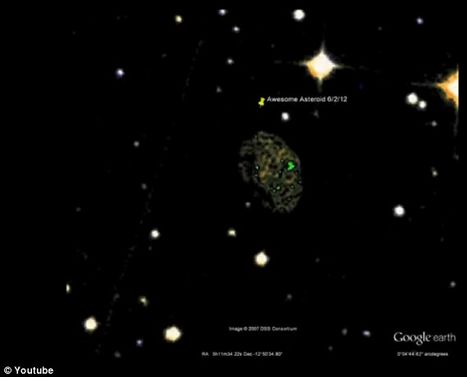
The asteroid - the co-ordinates of which are available below - was spotted by user planetkrejci in a video posted three days ago
A user has found a 'huge asteroid' while scanning the virtual heavens using Googly Sky.
Youtube user planetkrejci, who has investigated other anomalies on NASA pictures, claims the object - found using the Google website which transports the heavens to desktop computers and smartphones - is an asteroid which is heading towards Earth.
He says the asteroid - which, if real, has not been spotted by other scientists or astronomers - has only appeared recently on Google Sky, which receives updated images every few months.
Youtube user planetkrejci, who has investigated other anomalies on NASA pictures, claims the object - found using the Google website which transports the heavens to desktop computers and smartphones - is an asteroid which is heading towards Earth.
He says the asteroid - which, if real, has not been spotted by other scientists or astronomers - has only appeared recently on Google Sky, which receives updated images every few months.
Announcing his find on YouTube, he says the black object, mottled with green spots, is so clear that it must be within the solar system.
The user had been exploring the region a few months earlier, and had 'bookmarked' a spot just to the left of the asteroid - so he is certain the object was not there previously.
There are other explanations - this could be a simple technical glitch, either on Google Sky's end or within the original photograph.
The earthbound Google Maps regularly has glitches where pictures have been incorrectly sewn together.
The user had been exploring the region a few months earlier, and had 'bookmarked' a spot just to the left of the asteroid - so he is certain the object was not there previously.
There are other explanations - this could be a simple technical glitch, either on Google Sky's end or within the original photograph.
The earthbound Google Maps regularly has glitches where pictures have been incorrectly sewn together.
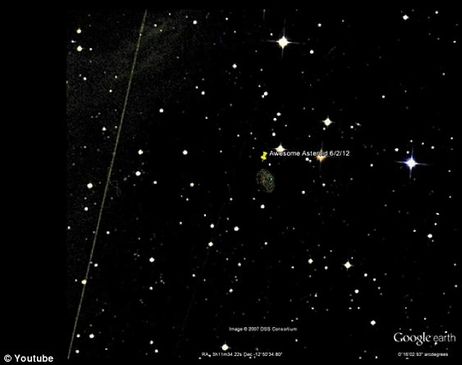
In context: The apparent clarity of the 'asteroid' implies it is close, certainly within our solar system
One thing that planekrejci does not substantiate is his claim that the object is moving towards the Earth, as it is not apparent how this calculation could be obtained without more information than the image provides.
However, if planetkrejci has found a new object, it will be quite an achievement for an earth-bound Internet user to discover a new object in our solar system before NASA or other observatories.
The object is easy to find on Google Sky, by typing in the co-ordinates 5h 11m 33.74s -12 50' 30.09" - although conspiracy theorists might read something into the fact that the search function on Google Sky is currently down...
However, if planetkrejci has found a new object, it will be quite an achievement for an earth-bound Internet user to discover a new object in our solar system before NASA or other observatories.
The object is easy to find on Google Sky, by typing in the co-ordinates 5h 11m 33.74s -12 50' 30.09" - although conspiracy theorists might read something into the fact that the search function on Google Sky is currently down...
Team Setting Up Strategy For Hazardous NEOs
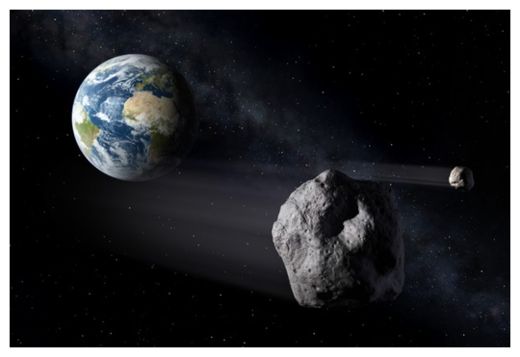
© ESA/Space Situational Awareness - Near Earth Objects, P. Carrill
To deal with potentially hazardous Near Earth Objects (NEOs) that could strike the Earth, there is need to establish an effective international communications strategy. The Near Earth Object Media/Risk Communications Working Group Report has been issued by Secure World Foundation.
Nearly 40 scientists, reporters, risk communications specialists, and Secure World Foundation staff participated in a meeting in November last year to come up with a strategy for dealing with hazardous NEOs.
The report created by the team will be presented at the United Nations Committee on the Peaceful Uses of Outer Space (COPUOS) and its Action Team-14 on NEOs during the 55th session of the UN COPUOS being held in Vienna, Austria.
During the meeting, the group explored in detail the views of risk communication experts and experienced science journalists on the development of a successful communications strategy.
"A lot of attention is focused on the catastrophic damage a large asteroid could do if it collided with Earth," Dr. Michael Simpson, Executive Director of Secure World Foundation, said in a press release. "This report focuses on how to prevent the even greater damage we could cause ourselves by mis-communicating or failing to work together on a common response to the threat."
He said the threat of an impact of a large asteroid could be what shows us that our future depends on working together.
"In technical organizations, communications with the public are often treated more as an afterthought than a critical mission element," Dr. Ray Williamson, SWF Senior Advisor, said in a press release. "This report emphasizes how important clear, effective, and accurate assessments to the public of the danger posed by a threatening Near Earth Object are to the ultimate goal of protecting human life and property."
The group determined that there is a need to establish an effective international communications strategy for potentially hazardous NEOs by using anything from the television to the Internet.
They said that general education should include information about NEOs and their place in our solar system, the nature of the potential threat, and specific information related to warnings of potentially hazardous NEO.
The experts determined that a support group should be created for hazardous NEOs, complete with analysts, planners, scientists, psychologists, emergency management experts and other functional experts.
Bright fireball seen from Queensland, Australia
Mr Bennedick runs the Wappa Falls Observatory at Yandina.
He says he was with a group of people who saw a bright fireball in the eastern sky about 11:00pm (AEST).
"We were coming back from doing the lunar eclipse in Brisbane and on the way back ... about 11 o'clock on the southern end of the coast, a very, very large what we call a fireball or a bolloid entered the atmosphere," he said.
"It was so bright that we could see the smoke trail in behind it - very, very blue, white colour."
Mr Bennedick says it looked like the meteorite was heading towards the Caloundra area or it might have entered the water.
New Comet - C/2012 K6 (McNaught)
Magnitude: 18.4 mag
Discoverer: Robert H. McNaught (Siding Spring)
The orbital elements are published on M.P.E.C. 2012-L04.
Large Fireball Over West Oklahoma and North Texas
orms One of the flashes across the sky wasn't lightning! 1 large Bolide or Fireball came roaring to earth. Reports are coming in from Oklahoma Of sonic booms caused as the fireball streaked towards Earth.
New Comet - C/2012 L2 (LINEAR)
Discovery Date: June 1, 2012 Magnitude: 19.4 mag Discoverer: Lincoln Laboratory Near-Earth Asteroid Research project
The orbital elements are published on M.P.E.C. 2012-L13.
Bright Near-Earth Asteroid 2012 LZ1
Here you can see an animation showing the motion of 2012 LZ1. Each frame is a 10-second exposure through the FTN 2.0-m telescope.
Huge Asteroid to Fly by Earth Thursday
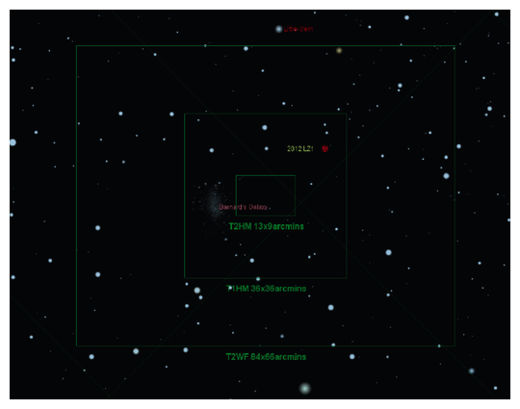
© Slooh Space Camera
A look at where near-Earth asteroid 2012 LZ1 will appear in the sky on the evening of June 14, 2012.
Large fireball seen in over Ohio, Pennsylvania, West Virginia and Southern Ontario
Did you see it? Lots of folks across northern Ohio did. A meteor streaking across the Ohio skies put on quite a show for a few brief seconds Thursday evening. Reports began coming in just after 10 p.m. on Thursday of a bright object streaking across the sky at about 9:55 p.m. "It was an incredible sight. It came from the south, streaked over head quickly and then within a second disappeared over Lake Erie," Kathy from Willoughby Hills, Ohio said. She described the sight as a bright white ball with a long, green tail. Steven from Wooster, Ohio saw it too. He said he also saw "2 or 3 pieces that came off bottom and were traveling at a slower velocity." The shooting star was observed across portions of Ohio, Southern Ontario, Western Pennsylvania, Ohio and West Virginia. Steven in Toronto, comments, "Never seen anything like it before. There was a main body of white streaking across the sky, (and) smaller objects near it." "Just saw a glow over the lake, green blue in color. (It) looked like a firework at first but we realized it wasn't." said K.J. from Sarnia, Ontario. Margaret from Perry, Ohio exclaims, "I have seen a few fireballs in my life. Never one that was green. So cool. looked like green sparks coming off initial fireball. Fireball faded with no flash. Glowing green and white that faded to white." The sight was also seen in Circleville, near Columbus, Ohio. "It was going horizontal all white, then it exploded in a red- orange It was white glowing trail," said Lloyd Poling. Shooting stars are common around the world as very small pieces of space rock burn up in the Earth's atmosphere. Most of the shooting stars are as small and create a quick, white streak across the night sky. Occasional, larger pieces of space rock, hit our atmosphere and create a show like many saw this night. "Most shooting stars are smaller than a grain of sand," said astronomer Jay Reynolds from Cleveland State University. "This one could have been nickel size, penny size." As for the color of the streak, that depends on the chemical make-up of the rock itself. "The green color of the tail tells you that the space rock was full of iron," said Reynolds. Shooting stars are mainly associated with the Earth's periodic encounters with dust from comet's tails. These meteor showers happen regularly several times per year. The next round is not expected until July 28 and 29, 2012 as part of the Delta Aquarids Meteor Shower. But, occasionally, experts say, a random rock finds its way to Earth. Adds Reynolds, "This was a little chunk of iron hanging out there in space and the earth got in the way."
Meteor Sighted Over Michigan/Ohio
International Space Station damaged by meteor
Everyone knows what a pain it is when you get a chip on your car's windshield from a bit of flying grit. But on Earth it is usually fairly easy to call someone in to repair it. NASA are currently evaluating a similar spot of damage to one of the viewing windows on the International Space Station to see if that needs to be replaced. The chip that left a visible scar on the outer pane was caused by a tiny meteoroid or scrap of space debris travelling many times faster than a bullet. It hit one of seven panes in the orbiting outpost's European-built Cupola - the space equivalent to a conservatory. This particular impact is not thought to put the six astronauts on board in any danger. But it is a reminder that space is a dangerous place. Astronauts aboard the ISS use the zone as a place to relax and watch the views of Earth and sky. It has provided some stunning images and videos recently of aurora displays and other spectacles including the recent Transit of Venus. A protective shutter was quickly closed over the damaged window, which has four layers of glass. The outer pane on the Cupola, which was carried into orbit by space shuttle Endeavour in February 2010, can only be replaced with a spacewalk. The astronauts currently on the ISS - Commander Oleg Kononenko and Flight Engineers Sergei Revin, Gennady Padalka, Joe Acaba, Don Pettit, and Andre Kuipers - took photos of the impact scar on Window Two of the Cupola and beamed them to mission control for analysis by experts. NASA are monitoring the orbits of the thousands of larger pieces of space junk left by satellite collisions and "star wars" tests in space. But smaller fragments plus natural meteoroid fragments flying through space are a constant hazard. Space debris expert Dr Lucy Rogers told Sen: "Space is full of tiny pieces of debris - both man-made and natural. It is estimated that there are hundreds of thousands of pieces of space debris, smaller than a cherry, travelling at speeds of up to 17,500 km/hr. "The space station is protected in many ways from damage by these pieces of debris. The windows of the ISS cupola are made from fused silica and borosilicate glass and are therefore much more resiliant than normal windows on Earth. However, a small piece of space debris can still cause it to chip, in the same way a car windshield will chip if hit by a small stone on the motorway. "Any chips that are seen on the cupola are reported directly to NASA, and the shutters of the orbital Debris Protection System (MDPS) on the Cupola will close. These shutters are made from aluminium and Kevlar/Nextel sheets, and will protect the astronauts should the pane of glass fail. NASA will carry out extensive investigations to ensure the integrity of the glass, before allowing the shutter to be opened again." Dr Rogers added: "There are equations used to predict penetration depth of projectiles - these can be used to calculate the size and speed of the debris that hit the window. The scientists will also be interested to see if they can work out what it was that hit the window - was it a broken part of another satellite, or was it small natural meteoroid? "This type of data helps the scientists and engineers calculate the probability of future micro-meteoroids and orbital debris (MMOD) strikes, and so precautions and safety measures can be taken to protect both astronauts and spacecraft. If a similar sized piece of debris had hit an astronaut on a spacewalk, the consequences may have been fatal."
Green fireball streaks across sky in southern England
'A green fireball' streaked across the sky above Beaconsfield on Friday night, according to motorist Graham Lee. The freelance photographer thinks he might have seen a meteor while driving home on the M40 and discovered several others had reported the sighting online. Graham, from Whiteleaf near Princes Risborough, told the BFP: "I was on the M40 coming to the Beaconsfield junction at about 11.30pm and it came from left to right.... "It only lasted a few seconds and I thought it was a firework, but thought crickey that's far too large and far too fast. "It was as bright as the sun and looked like a green fireball. I felt quite privileged to have seen it." A website called The Latest Worldwide Meteor Reports lists several sightings of 'fireballs', 'flashes' and 'green lights' at about the same time, in various locations around Oxfordshire. Ralph Campbell, Chairman of Aylesbury Astronomical Society, said Graham had probably seen a meteor, which is also known as a shooting star. He said: "They are not very frequent but occasionally you do see them. It's basically a lump of material from outer space coming into the earth's atmosphere. Because it's going so fast it heats up and melts away. "Very occasionally they will reach the earth and make a big hole in the ground, but fortunately we've avoided any really big ones up till now."
Unusual Sight Captured on Camera
Third daytime fireball seen in US this year, Meteor grounds air tankers fighting Colorado forest fire
An apparent meteor grounded heavy air tankers fighting the Springer fire near Lake George for nearly two hours Wednesday afternoon, leaving firefighters without air support. But the fiery phenomenon left people from as far away as New Mexico in awe. The planes were near Lake George when a pilot noticed debris falling from the sky, said Ron Roth, spokesman for the Rocky Mountain Area Coordination Center. The pilots were not sure whether it was "space junk" or a meteor, Roth said. "We're just glad it quit," Roth said. "A rather odd phenomenon." Several other reports pointed to a rare, once-in-a-lifetime sighting. Six reports of a meteor - seen from Winter Park, Colorado Springs and Raton, N.M. - were received by Chris Peterson, a research assistant with the Denver Museum of Nature and Science. The American Meteor Society received seven separate reports, mostly from Colorado Springs. "These things happen all the time, but usually they just aren't seen during the day," Peterson said. It likely wasn't one of the more than 22,000 pieces of "space junk" floating around the earth. Officials at the North American Aerospace Defense Command, which tracks man-made objects that threaten North America, did not report any scheduled entries or objects over North America, said Lt. Col. Mike Humphreys, a spokesman. The Joint Space Operations Center with U.S. Strategic Command did not track any man-made objects over Colorado, said Rodney Ellison, a spokesman for the agency. Relying only on witness reports - Peterson turns off his skyward cameras during the day - Peterson estimated the meteor likely screamed across the atmosphere somewhere above Limon. It could be seen for about three seconds, Peterson said, as it likely hurled anywhere from seven to 44 miles per second as it fell toward earth. Since it was visible during the day, the meteor likely was at least the size of a softball. Where it landed - or if it even reached the ground - remained anyone's guess Wednesday afternoon as the fire-fighting air tankers returned to the sky. Greg Heule, a spokesman for crews fighting the Springer fire near Lake George, said the tankers were struck by debris in the air. Peterson, though, said he couldn't recall a plane ever being hit by a meteor. "I would say it's really, really unlikely," Peterson said. "It's more likely that the plane was hit by flying pine cone ashes than a meteor." "Realistically, there's an awful lot of earth and not a lot of rocks falling from the sky." A good indication that a meteor fell nearby is the sonic boom that usually happens when a meteor falls to within 30 miles of the ground. At that point, the atmosphere is dense enough to cause the sound, as well as to make the meteor fall vertically. Though the fireball may have seemed close, don't bet on finding any pieces of space rock anytime soon, Peterson said. "It easily could have burned up," he said.
Comment: It's possible that a passenger jet was downed by an overhead meteor or cometary explosion in late May 2009: What are they hiding? Flight 447 and Tunguska Type Events This is the third (at least) such event in the US alone this year. 2 April 2012 April 2 Texas daytime fireball confirmed, another Meteor seen in Chicago Wednesday 23 April 2012 Second 'Rare' Daytime Fireball Explodes Over US This Month, Van-sized Meteor NOT part of Lyrid ShowerPossible Meteor Streaks Across Colorado Sky Wednesday
Raining fireballs! Two separate daytime meteors reported over US on same day, including Colorado wildfire meteor witnessed by two separate airline crews over Kansas and New Mexico
Authorities say there were increased reports of a possible meteorite or meteor shower today, one of which briefly grounded firefighting aircraft battling a central Colorado wildfire. One of the unconfirmed meteorite sightings came in from Salina around 6:31 PM, Wednesday. Meteorologist Scott Entrekin of the National Weather Service says emergency officials in Chaffee County, Colorado reported a possible meteor in the skies near the Springer Fire. They briefly grounded four single-engine aircraft fighting the 1,100-acre blaze west of Colorado Springs. Entrekin said Wednesday that the crews of 2 commercial aircraft flying over Liberal, Kan., reported what appeared to be a meteorite at 1:47 p.m. Central Daylight Time, or 12:47 p.m. Mountain time. He said the Colorado sighting occurred at about the same time. The Federal Aviation Administration has yet to confirm reports of a meteorite. It says there were no reported disruptions to commercial airlines. Source: Associated Press
Comment: For more on what appears to have been a remarkable explosion of atmospheric activity over the US Midwest on 20th June, read Reign of Fire: Meteorites, Wildfires, Planetary Chaos and the Sixth Extinction Colorado firefighters hampered by winds, heat -- and meteors
Firefighters in Colorado have battled the odds in trying to contain a blaze that has burned uncontrolled across 100 square miles of forest -- encountering precarious winds, heat and fatigue. On Wednesday, they contended with a new force: meteors. Authorities grounded firefighting aircraft as a precautionary measure after several reported meteor sightings near the High Park fire area they were trying to contain. Chaffee County Sheriff W. Peter Palmer told the Los Angeles Times that his office received four reports of meteors striking the ground. "People heard a boom; they saw things flying through the air, things like that," he said. "The local fire chief went looking for smoke to see if the impacts started another fire. That's the last thing we need." Steve Segin, a spokesman for the U.S. Forest Service, told the Associated Press that the crew of a heavy air tanker spotted something while making a slurry run on the blaze. "They weren't sure what it was," he said. "They landed as they normally do to reload, and for safety reasons they grounded themselves until they could figure out what it was they saw." The Colorado sightings corresponded with reports of a possible meteor filed by the crews of two commercial aircraft over Liberal, Kan., meteorologist Scott Entrekin of the National Weather Service in Boulder, told the AP. Other sky sightings were reported in Raton, N.M., he said. Fire officials ordered four single-engine aircraft to stay on the ground as a precaution. Two heavy air tankers were also affected. The planes soon resumed their attack on the fire, Entrekin said. The groundings came as firefighters were taking advantage of a break in the heat to ramp up their attack against the High Park fire burning on more than 100 square miles in the northern part of the state. In Chaffee County, Palmer said he doesn't doubt that residents saw something, but he's not sure what. "I don't know. I've been feeling kind of weak," he mused. "Maybe it was kryptonite."
A Different Kind of Climate Catastrophe
A few years ago, as a hobby, and pass-time, I set out to see if I could work out a better way of identifying potential sites to go meteorite hunting. I had learned to do battle damage assessment from aerial reconnaissance photos a long time ago in the Army. And the blast damage, and ground effects from an explosive event, are pretty much the same, no matter what the source of the explosion might be. It's only a question of scale, and explosive force. Visually, there is very little difference in the appearance of a bomb crater, and an impact crater of the same size. So a forensic technique of reading the patterns of movement in the emplacement of blast effected materials on the ground applies well in the search for potential impact related geology. The quality of the image data now commonly available to anyone with a good PC, an internet connection, and a copy of Google Earth, is excellent. In the past five years, the publically available image data has really come into its own. And today's 21st century satellite imagery allows us to study the surface of the Earth at a level of detail our fathers could never have imagined. Back in the 1920's, using aerial photography, a geologist named J. Harlan Bretz noticed evidence for the mega-floods that sculpted the Grande Coulee, and the 'Channeled Scablands' of eastern Washington. Bretz was the first to use Aerial photographs to detect, and map, catastrophic mass movement of the Earth's surface materials when he described the scarring of a catastrophic glacial flood event at the end of the last ice age, in an event he called The Spokane Flood. Aerial photography allowed him a perspective from which patterns of fluid flow, and catastrophic mass movement of terrain materials, could be perceived on a scale that had been unimaginable until he described them. What he had found, were the patterns of fluid flow, like the ripples you see in the sedimentary deposits of a stream bed, but these 'ripples' are hundreds of feet high. Bretz saw them as empirical evidence of a major catastrophic flood event, on a scale that the standard theorists of his day thought was inconceivable. Today we know that all of the water came from a glacial lake now referred to as Lake Missoula. The huge lake formed in western Montana during the ice age, when a part of the Cordilleran Ice Sheet called the Purcell Trench lobe extended far enough south that it blocked the Clark Fork River in Northern Idaho. In a repeating cycle during the last ice age, when the lake level would get high enough, the ice damn would fail releasing a catastrophic flood downstream. Then the glacier would continue to advance, blocking the river again, and the cycle would repeat. More 600 cubic miles of water was released each time that ice dam on the Clark Fork River would fail. And the volume of the resulting flood torrents has been calculated at 8 to 10 cubic miles per hour. Or flow a rate that amounts to 10 times the combined flows of all the rivers on the planet Earth. It turned out J.Harlan Bretz was exactly right. Although most of the academic community of his time thought he had a screw loose, or two. Almost a hundred years before him, most geologists had already decided to agree without question that sudden, catastrophic, geologic changes just didn't happen anymore. And that all geomorphology on the surface of the Earth is the result of slow processes we see going on around us today, and requiring millions of years. They were naively mistaken. One of the biggest mysteries I've ever confronted lies in the question of how theoretical geology could be so far removed from the empirical reality now clearly visible, and legible, in modern 21st century satellite images. It didn't take much digging in the history books to figure out where the Earth sciences went wrong. The root problem with the thinking in the Earth sciences goes all the way back to Gottfried Leibniz, in the early 18th century, and his slogan of 'Natura Non Facit Saltus', (Nature does not jump). Leibniz may have been a mathematical genius. But he wouldn't even pass a 5th grade geology test of today. Yet he had the full backing of governments, big business, and the big churches. Because he believed, and taught, that the Great God of the Universe had created planet Earth, with all its flora, and fauna, just for us, and to do with as we pleased. The old clichés like 'buying a pig in poke', 'don't let the cat out of the bag', and 'empty sack of lies' all have their roots in the same old con. It went something like this: At an old country fair, a con artist would approach a likely looking mark to sell him a piglet in a 'poke' bag. But it's not really a pig in the bag; it's a cat. The cat wiggles, and squirms, just like a little pig when you poke him through the bag. And as long as the bag stays closed, the con works just fine. But as soon as the bag is opened, the cat escapes. And the victim is left holding nothing but an empty sack of lies. Carl Linnaeus, and Charles Darwin, loved Leibniz. And they both quoted him verbatim. He managed to almost completely eliminate any academic consideration of episodic worldwide catastrophes from western thinking. And by the time James Hutton, and Charles Lyell, came along, most geologists were well-conditioned followers of his way of thinking. Hutten gets the credit for the origin of Uniformitarianism. Charles Lyell just popularized his ideas in 1830, when he published his book 'Principles of Geology'. But Hutten, and Lyell, just picked up on Leibniz's thinking, and ran with it. They weren't brilliant geological thinkers either. But their unquestioned uniformitarian/gradualist assumptions, based on the idea that the earth was shaped only by slow-moving forces still going on around us today, and expressed in the slogan of "The present is the key to understanding the past", has become the foundation postulate of the Earth Sciences ever since. Governments, and big institutions, loved it. And they bought it like a pig in a poke with generous funding packages that came with rules that shut the door to any consideration, or publication, of theories of sudden catastrophic events, as a possible driving force in the geo-morphology of this world for more than 150 years. That's a cruelly long time time to leave the poor kitty in a bag. But the questions of just what the hell happened around 13,000 years ago that caused the extinctions of the mega fauna in North America, the disappearance of the Clovis culture, and a return to Ice age conditions that lasted more than a thousand years, has caused us to take a closer look, and I'm afraid we've let the cat out of the bag. The trouble we face today, Just as Mr. Bretz did back in the 1920s, is that through the same 19th century process of mutual-inter-assumptive reasoning, and confabulation, instead of sound, experiment-driven, science, the Earth sciences are still founded on that unquestioned 'Gradualist' assumption. But gradualism only works until something sudden happens. And Harlan Bretz showed us that if you want to understand, or predict, the nature of the planetary scarring of a geologically recent catastrophic event, especially one that's different from anything that's ever been studied before, Sir Charles Lyell's 19th century, gradualist-assumptive, reasoning just won't get you there. Apparently, being able to see the truth is no guarantee that anyone's going to bother to look where you're pointing anytime soon. It wasn't until 1965 that a report from an independent geologist's tour concluded that Harlan Bretz was right. And finally, in 1976, at the age of 96, hewas awarded the Penrose Medal of the Geological Society of America. Which is just about the most prestigious award a person can get in the field of geology. Upon receiving the award, Mr. Bretz is said to have complained to his son that he couldn't gloat properly, because all of his enemies were dead. The satellites of today have raised the ante. Using aerial photography from blimps, and airplanes, Bretz could see evidence of catastrophic material movement on a statewide scale. With the imagery now available through Google Earth, we can detect, and read, patterns of catastrophic mass movement of terrains on a continental scale. The event Bretz perceived was only implausible from a standard theory viewpoint because of its size. And yet, by comparison, and in the final analysis, someday it may be seen that his glacial mega flood in the Pacific Northwest was only a minor little footnote in the events of the early Holocene. And some of those events were far more terrible then a glacial flood. In June 1908, an explosion rocked a remote, swampy area in central Siberia, in Russia; it came to be known as the "Tunguska event." And a later expedition to the site found that 20 miles of trees had been knocked down and set alight by the blast. Today, it's understood that Tunguska's devastation was caused by a 100-foot asteroid that had entered Earth's atmosphere, causing an airburst. Some 13,000 years earlier, just after the end of the last ice age, the Earth's climate had begun to warm up to temperatures much like what we enjoy today, when an occurrence thought by many researchers to be some kind extraterrestrial impact set off an "impact winter", and a return to ice age conditions that lasted another 1,300 years, or so. And the event coincided with the end of the prehistoric Clovis culture. And the mass extinction of almost all of the giant animals that lived on North America at the time. Perhaps the single most important paper on the subject of the Younger Dryas Cooling, is the 2007 paper by R.B. Firestone et al, and titled: Evidence for an extraterrestrial impact 12,900 years ago that contributed to the megafaunal extinctions and the Younger Dryas cooling The 2007 Firestone paper caused a pretty good stir in the academic community. And it has become the 'Flagship', so to speak, of the Younger Dryas impact hypothesis. In it, a team of twenty six scientists studying sedimentary deposits from sites all over North America presented a whole suite of compelling evidence for a massive impact event of a comet that appears to have broken up, and scattered, fragments all across North America. The multiple, air bursts are thought to have triggered wide-spread bio mass burning on a continental scale. As well as causing a return to ice age conditions, and the extinction of many species. Including the mega fauna, like mastodons, wooly mammoths, and giant sloths. In all, I think something like 35 genera went extinct. Its exact cause is by no means, a settled science though. And the biggest weakness in the YD impact hypothesis, as written, is that it's impossible to construct a model with a four mile wide bolide that has enough time in the atmosphere to break up completely, and scatter fragments, and devastation over a continent sized area, without making a good sized crater somewhere. And "where's the crater?" became a rallying cry of opponents to the hypothesis. The debate continues to go around, and around. Firestone, and friends, had found compelling evidence in the stratigraphic record that implied some kind of very large impact related catastrophe had occurred to trigger the Younger Dryas Cooling, and the megafaunal extinctions. But it was clear that the event was vastly different from anything that had been studied before. So they could only speculate on just exactly what the nature of the event was, or what had hit us, or where the actual impact zones were. Without an astronomical model that could confidently describe the the nature of the impactor/s, they were were at an impasse. Meanwhile, astronomers Victor Clube, and William Napier, in their book The Cosmic Serpent, had been talking about the giant comet they described as the progenitor of the Taurid Complex since 1982. Their data is as solid as anything you can dig up with a trowel. But except for them, and a few others like Bob Kobres, no one had connected the the dots, and put the Younger Dryas comet, and the Taurid Progenitor together. Except in private, speculative, emails, and letters. And to the best of my knowledge there was nothing in refereed literature. Then, In early 2010, Professor Napier published a paper in the Journal Monthly Notices of the Royal Astronomical Society titled, Paleolithic extinctions and the Taurid Complex in it we read: "The proposition that an exceptionally large comet has been undergoing disintegration in the inner planetary system goes back over 40 years (Whipple 1967), and the evidence for the hypothesis has accumulated to the point where it seems compelling. Radio and visual meteor data show that the zodiacal cloud is dominated by a broad stream of largely cometary material which incorporates an ancient, dispersed system of related meteor streams. Embedded within this system are significant numbers of large NEOs, including Comet Encke. Replenishment of the zodiacal cloud is sporadic, with the current cloud being substantially overmassive in relation to current sources. The system is most easily understood as due to the injection and continuing disintegration of a comet 50-100 km in diameter. The fragmentation of comets is now recognized as a major route of their disintegration, and this is consistent with the numerous sub-streams and co-moving observed in the Taurid complex. The probable epoch of injection of this large comet, ~20-30 kyr ago, comfortably straddles the 12.9 kyr date of the Younger Dryas Boundary. The hypothesis that terrestrial catastrophes may happen on timescales ~0.1 Myr, due to the Earth running through swarms of debris from disintegrating large comets, is likewise not new (Clube & Napier, 1984). However the accumulation of observations has allowed us to build an astronomical model, closely based on the contemporary environment, which can plausibly yield the postulated YDB catastrophe. The interception of ~1015 gm of material during the course of disintegration is shown here to have been a reasonably probable event, capable of yielding destruction on a continental scale. The object of this paper is not to claim that such an encounter took place at 12,900 BP - that is a matter for Earth scientists - but to show that a convincing astronomical scenario can be constructed which seems to give a satisfactory match to the major geophysical features of the Younger Dryas Boundary data. If indeed the YDB event was an astronomical catastrophe, its occurrence bears little relation to current impact hazard assessments derived from NEO surveys." With Professor Napier's work specifically proposing in refereed literature that the Taurid Progenitor was the Younger Dryas comet, he changed the game completely. Because he didn't just give us a convincing astronomical model of the event. We also have a pretty good picture of the physical properties of the thing that did the disastrous deed. And if you can describe a beast, you can predict it's footprints.
Recent Earth-Passing Asteroid is Much Bigger Than Originally Estimated
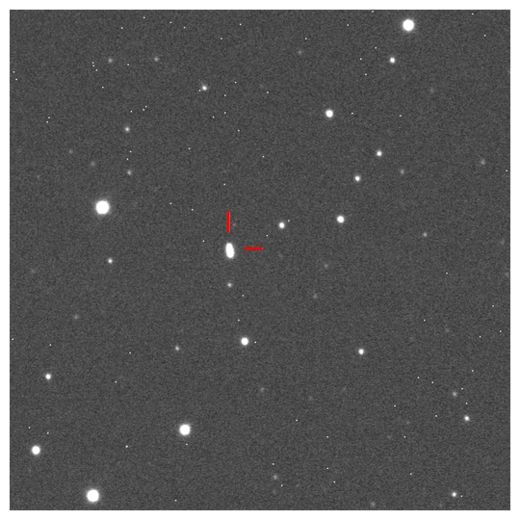
© Nick Howes, Ernesto Guido & Giovanni Sostero Asteroid 2012 LZ1 as seen by the Haleakala-Faulkes Telescope North on June 13, 2012.
Meteor may have started Lake George blaze in Colorado
Bellvue, Colorado - More people evacuated by the most destructive fire in Colorado history are set to return home today. It's the second wave of evacuees allowed back in two days as firefighters ramp up their attack on the wildfire that's burned over 100 square miles and destroyed at least 189 homes. Fire managers say the blaze is 55 percent contained. Meanwhile, firefighters are making progress against another blaze in central Colorado, which may have been caused by a meteor. The 2-square-mile wildfire near Lake George is 39 percent contained. The county sheriff says his office received multiple reports, including one from a person who thought a meteorite might have landed in a wooded area north of Buena Vista. He says officials could not confirm that report. The National Weather Service says the Colorado sightings correspond with a report of a possible meteor filed by the crews of two commercial aircraft over Kansas and another over New Mexico, near the Colorado State line. Source: Associated Press
Comment: Reign of Fire: Meteorites, Wildfires, Planetary Chaos and the Sixth Extinction Daylight Fireball Dazzles Colorado, Grounds Fire Tankers
A dazzling daytime fireball zipped across New Mexico and Colorado yesterday creating a stir among law enforcement agencies, news organizations, radio stations and briefly grounded air tankers fighting wildfires west of Colorado Springs. According to the Denver Post, Pueblo air-dispatch received reports of "balls of fire or something in the air." As a precaution, officials grounded flights to ensure no aircraft were hit. Flights resumed 90 minutes later. The event occurred between 12:35 and 12:40 MDT Wednesday afternoon. Witnesses say the fireball lasted about 3 seconds about 45 degrees above the ground, heading from the north to the south and ending near the horizon, with a tail color ranging from bright white to yellow and red. Some of the nearly 20 reports received by the American Meteor Society report that the brightness of the fireball was brighter than a full moon; some reporting it brighter than the Sun. A fireball is a meteor that is larger and brighter than normal. Although typically visible after sunset, dramatic fireballs have been recorded during the daytime, such as the April 22, 2012 bright daytime meteor that was seen over California in the US. Usually meteors are smaller than a pebble and move very fast. As the object encounters increased friction from the air in the upper atmosphere, it begins to get hot and glow. Most meteors burn up before hitting the ground. But some survive to be picked up and put in museums. Scientists estimate that nearly 100 tons of space dust lands on Earth every day. Most of it lands in the ocean. The North American Aerospace Defense Command (NORAD) based at Peterson Air Force Base near Colorado Springs told the Denver Post they were not tracking any man-made objects in the area. The Denver Museum of Nature and Science has meteor cameras stationed around the state. Unfortunately, they are turned off during the day and no video or pictures have surfaced. Astronomers and meteor/meteorite enthusiasts will certainly be interested in seeing any pictures or videos of the event, and so are we! If saw the event, or happened to capture it on a camera or surveillance video, you can send it to us or post it on our Flickr page.
Local Fire Chief Fears "Humongous" Fireball Could Have Started Wildfire In Colorado
Several residents reported seeing an unidentified flying object - later identified as a meteor - fly or fall over Salida at about 12:30 p.m. Wednesday. One Chaffee County resident, Sharon King, said she saw a glowing bright white light in the sky while sitting on her porch. King told The Mountain Mail Thursday that she at first thought it was the glimmer of an airplane, until she saw the bright red tip. "I watched it arch and fall to the ground," she said. The whole viewing took about 5 seconds, King said. She said she believed it fell somewhere in Piñon Hills and searched with binoculars - without success - for signs of smoke. "It was pretty awesome. I've never seen anything like that in my life. It was an exceptional sight," she said. Chaffee County Fire Protection District Chief Jim Wingert said two people reported they thought the meteor landed in the Fourmile Recreation Area. Other reports thought it landed in the Turret area. Wingert said he and other firefighters checked the recreation area but found no signs of smoke. His concern was that a piece of the meteor could potentially start a wildfire. One of his firefighters saw the meteor "clearly go past the horizon," Wingert said. He said people reported the size of the meteor to be smaller than a house and larger than a vehicle. One claimed the tail was about 2 miles long, Wingert said. As a precaution, fire officials temporarily grounded firefighting aircraft at the Springer Fire for about 1½ hours, Dawn Sanchez, U.S. Forest Service public affairs officer, said. Wingert said the Federal Aviation Administration received reports of a meteor over Kansas. "It must have been humongously large. I think this thing went down on the East Coast or in another country," he said, "but wherever it landed, you can be sure it made a ker-thunk."
Comment: Reign of Fire: Meteorites, Wildfires, Planetary Chaos and the Sixth Extinction Fireball sighted over Gloucestershire
Unidentified flying objects have been reported over Gloucester, re-igniting fresh theories on alien life. Several reports have been made to police and astronomy websites flagging up the unusual sightings over Gloucester and Cheltenham on Friday, June 15, at around 11.30pm. Carl Sumners, 23, who spent six years in the Royal Navy and had three tours in Afghanistan with the Commando Helicopter Force, told us what he saw over his house in Roman Road, Gloucester. He feared the turquoise object was a meteorite heading for a populated area, so called the police. "It was the size of a wheelbarrow, 2,000ft in the sky and travelling faster than a fighter jet," he said. "It seemed to be on fire as it had an orange tail behind it. There must be some kind of logical explanation, maybe it was a meteor. It definitely wasn't a Chinese lantern or weather balloon." Rob Burgess, of Cheltenham, reported a sighting at 11.47pm on the same night. It has been logged on international astrology website, Meteorite News. He saw a bright white object moving from left to right, followed by a trail of light before moving behind a low dark cloud. Police said they received a report from a resident in Middleton Lawn in Innsworth at the same time. A police spokesman said: "We had a report of an object falling from the sky that was followed by a bright blue flame, the piece that fell from it was bright yellow in colour." The sightings follow strange bright lights circling over Podsmead last month. Experienced astronomer John Fletcher, who star-gazes from his Tuffley observatory, said: "There is a million-to-one chance this was anything other than a man-made object," he said. "It was a UFO, but that doesn't mean it was some kind of alien life-form or meteorite. It is very difficult to get any kind of perspective or idea of distance at night. "I have seen embers from a fire in the sky at night and they can look absolutely stunning. It is easy to see why people would think it could be something else. "The only advice I can offer is for someone to look through binoculars or a telescope first be reporting anything."
Comment: With more and more sightings of meteors and meteorites all over the world, there are still those who would like the rest of us to close our eyes to what is really happening. Earth's oldest known impact crater found in Greenland

© Unknown Black circle on map shows the location of the meteorite impact structure near the town Maniitsoq in Greenland.
Alleged 'fireball' streaks across Louisiana sky
West Monroe resident Obie Sims said he was enjoying a relaxing evening outdoors Thursday when he saw what appeared to be a huge bottle rocket streak across the sky about 10:45 p.m. About a minute later, Sims said he heard a loud boom and his windows shook. "I thought it was someone shooting fireworks," he said. "I must have just seen the tail of it and then it fizzled away." Don Wheeler, an associate professor of natural science at Louisiana Delta Community College, said the occurrence was likely what is referred to as a "fireball", a small meteor that enters the atmosphere. Wheeler said it is not unusual for meteors to enter the atmosphere, but the size makes fireballs more noticeable. "It was likely the size of anywhere from a grapefruit to a basketball," he said. "Most often they are about the size of a key or even a grain of sand." According to Wheeler, the larger size carries it deeper into the atmosphere and the speed of its journey often triggers a sonic boom. "It was likely traveling in excess of 768 miles per hour, which is roughly the speed of sound," he said. The National Weather Service in Shreveport said they heard reports of an occurrence Thursday, which they assume was a meteor. Wheeler said there was a similar event in March 2010 when a fireball streaked across the sky and could be seen from Shreveport to Jackson. Another similar meteor was sighted five days later. Those two meteors occurred during a minor meteor storm. Wheeler said there is no prediction of a meteor shower this week.
On Anniversary of Tunguska, Meteor Plunges into Indian Ocean, Lighting up Perth sky
This fiery streak in the sky amazed Perth beachgoers at sunset as a suspected meteor plunged into the ocean off the WA coast. Pip Moir posted this photo she took at Cottesloe Beach to Twitter shortly after 6pm as puzzled onlookers debated what caused the colourful phenomena. A spokesman for the Bureau of Meteorology said the weather bureau's radar would not pick up a fast moving object like a meteor. Daniel Jongue, manager at The Naked Fig Cafe, said he noticed ''something on the horizon'' just before sunset. He said the fiery trail took about 20 minutes to dissipate. ''It looked like vapour. It was red, orange and yellow and quite beautiful,'' he said. Perth Observatory and Astronomy WA could not be reached for comment last night.
Comment: Tunguska, Psychopathy and the Sixth Extinction Tunguska, the Horns of the Moon and Evolution June 30, 1908: The Tunguska Event
"It was nothing of this earth, but a piece of the great outside; and as such dowered with outside properties and obedient to outside laws." The Colour Out of Space, by H.P. Lovecraft (1927)
In the morning of June, 30 1908 eyewitnesses reported a large fireball crossing the sky above the taiga of the Stony Tunguska (PodkamennayaTunguska) in Siberia. A series of explosions was heard even in the 1.200km distant village of Achajewskoje. Various meteorological stations in Europe recorded seismic and pressure waves and in the following days strange atmospheric phenomena were observed, silvery glowing clouds, colourful sunsets and strange luminescence in the night. Russian newspapers reported about a meteorite impact based on the eyewitness accounts and the hypothesis of Dr. Arkady Voznesensky (1864-1936), director of the Meteorological Observatory at Irkutsk from 1895 to 1917. International newspapers speculated about a possible volcanic explosion, remembering the eruption of Krakatoa in 1883. However the inaccessibility of the region and the instable political situation in Russia prevented further research. Thirteen years later the Russian mineralogist Leonid Alexejewitsch Kulik (1883-1942), reading some of the eyewitnesses' accounts about an explosion and a large glowing object, became interested in the phenomena - there was also the hope to recover precious extraterrestrial metals from the supposed meteorite. Kulik travelled to the city of Kansk, where he discovered further reports in the local archives. Most stories refer to large fireballs, flames and a sequence of 14 thunders. March 1927 he arrived at the outpost of Wanawara -then, April 13, Kulik discovered a large area of 2.150 square km covered with rotting logs and almost no tree still standing - the strange "Forest of Tunguska". Despite an intensive survey, Kulik and his team didn't locate a single great impact crater as expected, but found some circular pits that were interpreted as impact craters of fragments; however no meteoritic material was discovered in the entire studied area. In autumn 1927 a preliminary report by Kulik was published in various national and international newspapers, the destroyed forest and the event became known as the "Tunguska Event". Kulik formulated one of the first hypotheses to explain the phenomena and the lack of evidence on the ground, as he proposed that a bolid exploded already in the atmosphere, causing the observed explosion and devastation. Fragments became buried in the swampy ground, to soft to preserve the typical morphology of an impact crater. Also later expeditions in 1929 failed to find extraterrestrial material. In 1934 Sowjet scientists proposed a variation of the meteorite-hypothesis. A comet is composed mostly of ice, and would be completely vaporized in an explosion in the atmosphere. The lack of direct evidence generated many more or less serious speculations and hypothesis: The engineer Aleksander Kasantsews formulated between 1945 and 1959, based on the impression left by the first atomic bombs, an unusual explanation involving a nuclear explosion of possible extraterrestrial origin. American physicists published in 1973 in the journal Nature the idea that a small black hole collided with earth, causing some sort of matter-antimatter explosion. The German astrophysician Wolfgang Kundt and later Jason Phipps Morgan of the Cornell University in Ithaca and Paola Vannucchi from the University of Florence proposed in the last years an ulterior hypothesis: "Verneshots", in reference to the author of the novel "A Journey to the Center of the Earth", are supercritical magma/gas mixtures erupting violently from the underground. According to the proposed model in areas with a thick earth crust or composed of resistant rocks (the region of Tunguska is covered by the basalts of the Siberian Trapps) magmatic intrusions and gases tend to build up pressure until the cover is shattered to pieces. Hot gases escape into the atmosphere, causing a huge explosion. However the most compelling hypothesis remains the impact of a natural extraterrestrial object. This hypothesis is supported by the reports describing a fireball descending on the tundra, sedimentary features (the presence of nanodiamonds, magnetic- and silicate spherules in sediments) and the mapped distribution of the logs. But there are some inconsistencies - accounts of a series of thunders are hard to reconcile with a single impact and the recovered sediments are not unambiguous, explainable also by the common background sedimentation of extraterrestrial material on earth. In 2007 Luca Gasperini and his research team of the University of Bologna proposed a small lake as possible impact crater of a fragment of the meteorite that caused the explosion. Lake Cheko is unusually deep for a region characterized by shallow ponds, formed by melting permafrost. The lake was apparently not reported previously of 1908, however the region was poorly mapped and explored at the time. Also here the proposed evidence is not undisputed as seen in the published paper by COLLINS et al. in 2008. Only the discovery of extraterrestrial material on the bottom of a lake would (may)be the decisive argument to settle the discussion of the mystery of Tunguska. Even Carl Sagans seems to be puzzled by the Tunguska Mystery...
Burning meteorite trail lights up Australian sky for 20 minutes after rock plunges into the sea
A burning trail lit up the sky over Western Australia for 20 minutes after an object suspected to be a meteorite plunged into the sea, leaving a burning orange trail that mesmerised local residents. Beachgoers in Perth debated what could have caused the strange burning line in the sky, which persisted for 20 minutes. Most meteorite trails are only seen briefly - and seeing an object plunge into the sea is rare. Local resident Gavin Trought captured a picture of the 'burning streak', saying, ' The weird streak in the sky seen from Cottesloe last night. I noticed it just before sunset.' Meteorites are fragments of rock that land on Earth's surface. Those that burn up - 'ablate' - in Earth's atmosphere are referred to as meteors. Seeing such clear, fiery trails is rare. Perth journalist Pip Moir posted a photo she took at Cottesloe Beach to Twitter shortly after 6pm as puzzled onlookers debated what caused the colourful phenomena. Daniel Jongue, manager at Perth's The Naked Fig Cafe, said he saw 'something on the horizon'' just before sunset. Jonque said that the fiery trail lasted for around 20 minutes. 'It looked like vapour. It was red, orange and yellow and quite beautiful,' he said. Meteorites are fragments of rock and sometimes metal that survive the fall to Earth from space. Most are fragments left over from the collision of two asteroids. Captured by Earth's gravitational force, they are accelerated to speeds of over 11.2 kilometres per second. They can vary in size from a fraction of a millimetre to larger than a football pitch. It is believed a meteorite six miles across wiped out the dinosaurs 65million years ago. Hundreds of meteorites fall to Earth each year but only a handful are recovered.
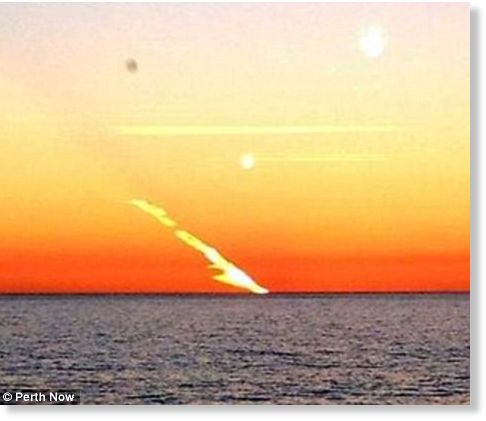
A 30-year-old YouTube user from Spain, ToniAmazing7, posted a UFO video online with a title that indicated that the video was recorded somewhere over Spain on July 8, 2012. Unfortunately, those claims have turned out to be untrue. The video was actually recorded at least one month ago, allegedly in Iraq, making this another case of recycled UFO video footage. If you haven't seen it yet, it is still worth a look regardless of where and when it was actually recorded.
The video shows an extraordinarily bright line in the sky that gradually opened into a sphere with a cone-shaped tip. The cone and sphere both eventually dissipated as if they were made of smoke, but they left behind a bright, spiral-shaped trail in the dark sky that lingered indefinitely. In the past, some spiral-shaped unidentified flying objects have been attributed to failed missile launches.
The video actually appears to be turned 180 degrees so the horizon is shown vertically along the right side of the image. That means the UFO in the video was actually moving straight up from the ground, not horizontally across the sky as it seems at first glance.
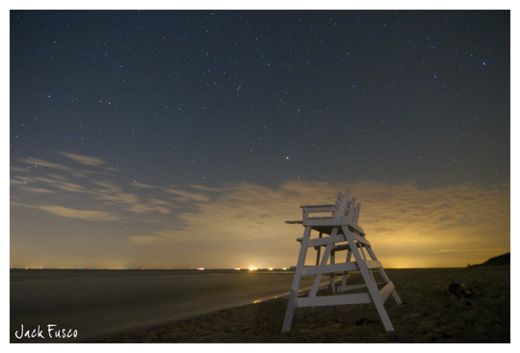
Photographer Jack Fusco captured this serene view of a Bootid meteor over Cape May, N.J., at 2 a.m. ET on June 28, 2012. The Bootid meteor shower is an annual, but faint, display in late June.
A fleeting meteor streaks across the night sky over a New Jersey beach in serene view captured by a local photographer.
Night sky photographer Jack Fusco captured the meteor as it flared up over Cape May, N.J., beach in the wee hours of June 28, just after the peak of the annual Bootid meteor shower.
"The shower peaked about an hour after the moon had set, at about 2 a.m. EDT," Fusco told SPACE.com in an email. "Overall, it was a beautiful night for stargazing."
June's Bootid meteor shower is created by the remains of the Comet 7P/Pons Winnecke, according to the International Meteor Organisation.
The Bootid shower is classified as a variable meteor shower by the American Meteor Society because its annual displays are often dim, but can sometimes be impressive to lucky stargazers. Variable meteor showers typically only "produce strong activity on rare occasions," the society explains in an overview. "Most of the time, only a few scattered remnants of these showers are observered with rates of one shower member per night."
The Bootid meteor shower is one of several meteor showers to light up the night skies in the next few months.
The annual Delta Aquarid meteor shower is expected to hit its peak on July 29, but will likely be washed out by the nearly full moon, according to a NASA alert.
Next up is the annual Perseid meteor shower, which will peak on Aug. 12 and is typically one of the year's dependable shooting star displays. At its peak, the 2012 Perseid meteor shower could produce up to 100 meteors per hour for stargazers observing the night sky from a dark location, well away from city lights, between 10 p.m. and 11 p.m. local time, NASA officials said.
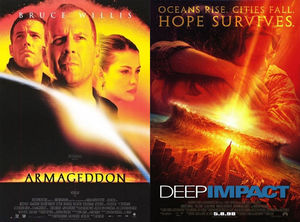
If it sounds like it's something out of a movie, that's because it is. They have no intention of diverting asteroids or any other Meteors or CFometary Fragments (MoCF). By now they will have run crunched the numbers and worked out that there is no man-made technology that can stop what's coming.
To avert a possible catastrophe -
this time set for February 2013 - scientists suggest confronting
asteroid 2012 DA14 with either paint or big guns. The stickler is that
time has long run out to build a spaceship to carry out the operation.
NASA's data shows the 60-meter asteroid, spotted by Spanish stargazers in February, will whistle by Earth in 11 months. Its trajectory will bring it within a hair's breadth of our planet, raising fears of a possible collision.
The asteroid, known as DA14, will pass by our planet in February 2013 at a distance of under 27,000 km (16,700 miles). This is closer than the geosynchronous orbit of some satellites.
There is a possibility the asteroid will collide with Earth, but further calculation is required to estimate the potential threat and work out how to avert possible disaster, NASA expert Dr. David Dunham told students at Moscow's University of Electronics and Mathematics (MIEM).
"The Earth's gravitational field will alter the asteroid's path significantly. Further scrupulous calculation is required to estimate the threat of collision," said Dr. Dunham, as transcribed by Russia's Izvestia. "The asteroid may break into dozens of small pieces, or several large lumps may split from it and burn up in the atmosphere. The type of the asteroid and its mineral structure can be determined by spectral analysis. This will help predict its behavior in the atmosphere and what should be done to prevent the potential threat," said Dr. Dunham.
In the event of a collision, scientists have calculated that the energy released would equate to the destructive power of a thermo-nuclear bomb.
In response to the threat, scientists have come up with some ingenious methods to avert a potential disaster.
Fireworks and watercolorsWith the asteroid zooming that low, it will be too late to do anything with it besides trying to predict its final destination and the consequences of impact.
A spaceship is needed, experts agree. It could shoot the rock down or just crash into it, either breaking the asteroid into debris or throwing it off course.
"We could paint it," says NASA expert David Dunham.
Paint would affect the asteroid's ability to reflect sunlight, changing its temperature and altering its spin. The asteroid would stalk off its current course, but this could also make the boulder even more dangerous when it comes back in 2056, Aleksandr Devaytkin, the head of the observatory in Russia's Pulkovo, told Izvestia.
Spaceship impossible?
Whatever the mission, building a spaceship to deal with 2012 DA14 will take two years - at least.
The asteroid has proven a bitter discovery. It has been circling in orbit for three years already, crossing Earth's path several times, says space analyst Sergey Naroenkov from the Russian Academy of Sciences. It seems that spotting danger from outer space is still the area where mere chance reigns, while asteroid defense systems exist only in drafts.
Still, prospects of meeting 2012 DA14 are not all doom and gloom.
"The asteroid may split into pieces entering the atmosphere. In this case, most part of it will never reach the planet's surface," remarks Dunham.
But if the entire asteroid is to crash into the planet, the impact will be as hard as in the Tunguska blast, which in 1908 knocked down trees over a total area of 2,150 sq km (830 sq miles) in Siberia. This is almost the size of Luxembourg. In today's case, the destination of the asteroid is yet to be determined.
Comment: This is just a ruse to make you think the government can actually do anything about what's coming. It can't. There's no hope to be found in their system.
Reign of Fire: Meteorites, Wildfires, Planetary Chaos and the Sixth Extinction
 A fleeting meteor streaks across the night sky over a New Jersey beach in serene view captured by a local photographer.
A fleeting meteor streaks across the night sky over a New Jersey beach in serene view captured by a local photographer.
Night sky photographer Jack Fusco captured the meteor as it flared up over Cape May, N.J., beach in the wee hours of June 28, just after the peak of the annual Bootid meteor shower.
"The shower peaked about an hour after the moon had set, at about 2 a.m. EDT," Fusco told SPACE.com in an email. "Overall, it was a beautiful night for stargazing."
June's Bootid meteor shower is created by the remains of the Comet 7P/Pons Winnecke, according to the International Meteor Organisation.
The Bootid shower is classified as a variable meteor shower by the American Meteor Society because its annual displays are often dim, but can sometimes be impressive to lucky stargazers. Variable meteor showers typically only "produce strong activity on rare occasions," the society explains in an overview. "Most of the time, only a few scattered remnants of these showers are observered with rates of one shower member per night."
The Bootid meteor shower is one of several meteor showers to light up the night skies in the next few months.
The annual Delta Aquarid meteor shower is expected to hit its peak on July 29, but will likely be washed out by the nearly full moon, according to a NASA alert.
Next up is the annual Perseid meteor shower, which will peak on Aug. 12 and is typically one of the year's dependable shooting star displays. At its peak, the 2012 Perseid meteor shower could produce up to 100 meteors per hour for stargazers observing the night sky from a dark location, well away from city lights, between 10 p.m. and 11 p.m. local time, NASA officials said.

Perth Sunset Mystery: Was the Fiery Trail a Meteor?
The sunset off the WA coast looked extra spectacular Friday as an object believed to be a meteor made a stunning view. A long yellow orange fiery trail is seen over the horizon over Cottlesloe, and photos of the sight immediately spread on Twitter.
However, it has not been confirmed whether the blazing display of colourful light was indeed a meteor plunge. PertNow reported it tried to reach Perth Observatory and Astronomy WA, but it "could not be reached for comment."
"The weird streak in the sky as seen from Cottesloe last night. I noticed it just before sunset," media reader Gavin Trought told PertNow in a photo caption.
"It looked like vapour. It was red, orange and yellow and quite beautiful,'' said Daniel Jongue, a manager at The Naked Fig Cafe.
Some readers who also saw the still mysterious phenomenon have commented on the PerthNow report.
"I live in the hills and was coming down about 5.45pm. I looked to the horizon and was amazed at what I saw. Not the same as this but pink in colour and going down in a straighter line than this picture. But still not something you would see normally," said reader blond61.
"I was at the beach 2 hours over the entire sunset. it was definately not a meteor. it was a plane's vapour trail, (a)nd was ordinary about 20 minutes before that photo was taken. (I)t was just the sunset that made it look so "fiery," said reader Troy.
"I work on the beach and saw that... got quite a few photos... it started before sunset as just a "smoke" or vapour trail... it was quite clean and straight so I honestly just thought it was a jetstream... hung around for a while and as the sun set it became the beautiful scene you see above. I'll be surprised to hear if it actually was a meteor," said reader Steve.
On Twitter, those who have seen the photos also weighed in on the scene.
@davidlmorris: Wondering if this was a jet contrail instead of what this paper claims
@dannews: Pretty sure it's just a contrail?
@ShiningStarKW: Wow what a sight! Poor fishes tho.
If you are an expert in the field or have seen the stunning sunset sky display, send in your comments and help in setting the "Perth meteor" record straight.
Vital eye for killer asteroids could shut imminently
A lack of cash could end the only survey dedicated to searching the southern skies for Earth-grazing comets and asteroids. That would create a blind spot in our global view of objects that could cause significant devastation should they hit Earth.
The Siding Spring Survey uses images from the Siding Spring observatory in Australia as part of the global Catalina Sky Survey, an effort to discover and track potentially dangerous near-Earth objects. Astronomers sift through virtually identical images of the sky, looking for moving objects.
Catalina uses a range of northern hemisphere telescopes - and the Sliding Spring Survey. But in October, Catalina cut off cash to the survey due to growing costs, caused partly by changes in the exchange rate between the Australian and US dollars. That decision was "very difficult", says Steve Larson, who heads Catalina.
Since then, the southern survey has been limping along with temporary funding from the Australian National University in Canberra, but the extension is set to expire at the end of July, says survey operator Rob McNaught.
The leftover building blocks of planets, near-Earth objects orbit the sun in highly elliptical orbits, and sometimes graze or hit Earth. Seeing an asteroid before it hits could save lives by providing time to evacuate a region. "Given the very best circumstances, you can predict an impact to 1 second and 1 kilometre," says McNaught. "There's no other natural disaster that you can do that for."
But without a southern lookout, any object approaching Earth from below 30 degrees latitude would be invisible, says Tim Spahr of the International Astronomical Union's Minor Planet Center in Cambridge, Massachusetts.
That won't be much of a problem for massive objects like the asteroid that wiped out the dinosaurs. These are rare and astronomers estimate they have already found and are tracking 94 per cent of them via software models. The worry is asteroids about 30 metres wide, which could flatten a city. Such a hit is blamed for the Tunguska event in 1908, which levelled a 2000-square-kilometre swathe of forest in Siberia.
There are around a million of these smaller objects, making them the most likely to hit Earth, yet locations for less than 1 per cent of them are known. Without a southern telescope, "you could easily get blindsided by one of these", says Don Yeomans, of NASA's Near-Earth Object Program at the Jet Propulsion Laboratory in Pasadena, California. "Whether that's a 1 per cent, 10 per cent or 20 per cent increased risk, I don't know. But it is an increased risk."
What's more, as most asteroids and comets are tracked across both hemispheres, those discovered in the north could get lost without follow-up from the south. There will also be objects seen in the north that could have been spotted sooner in the south, giving more time to prepare.
McNaught estimates that the survey needs about US$180,000 per year, plus a one-off $30,000 to fix the observatory dome. "I really wish I could tell you that the chances are very good that we'll be able to find some money, but I can't," says Harvey Butcher, who heads the team at Australian National University that is providing temporary funding.
If the survey shuts down, there won't be another ground telescope capable of fulfilling its duties until the 2020s, when the Large Synoptic Survey Telescope is due to go online in Chile.
The non-profit B612 Foundation plans to build a space telescope to scan for small asteroids but it won't launch until at least 2017. "In the interim, having one eye closed when the cost of having it open is so little seems to be penny wise and pound foolish," says B612 co-founder Russell Schweickart, a former NASA astronaut.
The people's asteroid defence
Lisa Grossman
Citizens, defend thyselves. As governments prove slow at funding telescopes to monitor asteroids, a non-profit organisation plans to pick up the slack - though its telescope won't launch till 2017 at the earliest.
The B612 Foundation - named for the asteroid that was home to the prince in The Little Prince - has announced a plan to build, fly and operate the first private space telescope. Called Sentinel, it will cost several hundred million dollars, which the foundation hopes to raise through donations.
"We think this is eminently doable," says B612's Ed Lu, a former NASA astronaut, who compares the project to funding museums or concert halls. "This telescope will be owned by the people of the world."
Unlike ground-based surveys, Sentinel will orbit the sun, so its view will not be confined to one hemisphere. It will look in infrared wavelengths, so small asteroids that don't reflect much visible light can be seen via their heat. Planned for launch in 2017 or 2018, Lu predicts that Sentinel will find more asteroids in its first month than all previous telescopes combined.
The Siding Spring Survey uses images from the Siding Spring observatory in Australia as part of the global Catalina Sky Survey, an effort to discover and track potentially dangerous near-Earth objects. Astronomers sift through virtually identical images of the sky, looking for moving objects.
Catalina uses a range of northern hemisphere telescopes - and the Sliding Spring Survey. But in October, Catalina cut off cash to the survey due to growing costs, caused partly by changes in the exchange rate between the Australian and US dollars. That decision was "very difficult", says Steve Larson, who heads Catalina.
Since then, the southern survey has been limping along with temporary funding from the Australian National University in Canberra, but the extension is set to expire at the end of July, says survey operator Rob McNaught.
The leftover building blocks of planets, near-Earth objects orbit the sun in highly elliptical orbits, and sometimes graze or hit Earth. Seeing an asteroid before it hits could save lives by providing time to evacuate a region. "Given the very best circumstances, you can predict an impact to 1 second and 1 kilometre," says McNaught. "There's no other natural disaster that you can do that for."
But without a southern lookout, any object approaching Earth from below 30 degrees latitude would be invisible, says Tim Spahr of the International Astronomical Union's Minor Planet Center in Cambridge, Massachusetts.
That won't be much of a problem for massive objects like the asteroid that wiped out the dinosaurs. These are rare and astronomers estimate they have already found and are tracking 94 per cent of them via software models. The worry is asteroids about 30 metres wide, which could flatten a city. Such a hit is blamed for the Tunguska event in 1908, which levelled a 2000-square-kilometre swathe of forest in Siberia.
There are around a million of these smaller objects, making them the most likely to hit Earth, yet locations for less than 1 per cent of them are known. Without a southern telescope, "you could easily get blindsided by one of these", says Don Yeomans, of NASA's Near-Earth Object Program at the Jet Propulsion Laboratory in Pasadena, California. "Whether that's a 1 per cent, 10 per cent or 20 per cent increased risk, I don't know. But it is an increased risk."
What's more, as most asteroids and comets are tracked across both hemispheres, those discovered in the north could get lost without follow-up from the south. There will also be objects seen in the north that could have been spotted sooner in the south, giving more time to prepare.
McNaught estimates that the survey needs about US$180,000 per year, plus a one-off $30,000 to fix the observatory dome. "I really wish I could tell you that the chances are very good that we'll be able to find some money, but I can't," says Harvey Butcher, who heads the team at Australian National University that is providing temporary funding.
If the survey shuts down, there won't be another ground telescope capable of fulfilling its duties until the 2020s, when the Large Synoptic Survey Telescope is due to go online in Chile.
The non-profit B612 Foundation plans to build a space telescope to scan for small asteroids but it won't launch until at least 2017. "In the interim, having one eye closed when the cost of having it open is so little seems to be penny wise and pound foolish," says B612 co-founder Russell Schweickart, a former NASA astronaut.
The people's asteroid defence
Lisa Grossman
Citizens, defend thyselves. As governments prove slow at funding telescopes to monitor asteroids, a non-profit organisation plans to pick up the slack - though its telescope won't launch till 2017 at the earliest.
The B612 Foundation - named for the asteroid that was home to the prince in The Little Prince - has announced a plan to build, fly and operate the first private space telescope. Called Sentinel, it will cost several hundred million dollars, which the foundation hopes to raise through donations.
"We think this is eminently doable," says B612's Ed Lu, a former NASA astronaut, who compares the project to funding museums or concert halls. "This telescope will be owned by the people of the world."
Unlike ground-based surveys, Sentinel will orbit the sun, so its view will not be confined to one hemisphere. It will look in infrared wavelengths, so small asteroids that don't reflect much visible light can be seen via their heat. Planned for launch in 2017 or 2018, Lu predicts that Sentinel will find more asteroids in its first month than all previous telescopes combined.
Expanding UFO with spiral trail recorded in Spain or Iraq
Meteor Lights Up Beach Night Sky in Photo

© Jack Fusco
Photographer Jack Fusco captured this serene view of a Bootid meteor over Cape May, N.J., at 2 a.m. ET on June 28, 2012. The Bootid meteor shower is an annual, but faint, display in late June.
Night sky photographer Jack Fusco captured the meteor as it flared up over Cape May, N.J., beach in the wee hours of June 28, just after the peak of the annual Bootid meteor shower.
"The shower peaked about an hour after the moon had set, at about 2 a.m. EDT," Fusco told SPACE.com in an email. "Overall, it was a beautiful night for stargazing."
June's Bootid meteor shower is created by the remains of the Comet 7P/Pons Winnecke, according to the International Meteor Organisation.
The Bootid shower is classified as a variable meteor shower by the American Meteor Society because its annual displays are often dim, but can sometimes be impressive to lucky stargazers. Variable meteor showers typically only "produce strong activity on rare occasions," the society explains in an overview. "Most of the time, only a few scattered remnants of these showers are observered with rates of one shower member per night."
The Bootid meteor shower is one of several meteor showers to light up the night skies in the next few months.
The annual Delta Aquarid meteor shower is expected to hit its peak on July 29, but will likely be washed out by the nearly full moon, according to a NASA alert.
Next up is the annual Perseid meteor shower, which will peak on Aug. 12 and is typically one of the year's dependable shooting star displays. At its peak, the 2012 Perseid meteor shower could produce up to 100 meteors per hour for stargazers observing the night sky from a dark location, well away from city lights, between 10 p.m. and 11 p.m. local time, NASA officials said.
NASA: We might blast or paint asteroid threatening to impact Earth in 2013

If it sounds like it's something out of a movie, that's because it is. They have no intention of diverting asteroids or any other Meteors or CFometary Fragments (MoCF). By now they will have run crunched the numbers and worked out that there is no man-made technology that can stop what's coming.
NASA's data shows the 60-meter asteroid, spotted by Spanish stargazers in February, will whistle by Earth in 11 months. Its trajectory will bring it within a hair's breadth of our planet, raising fears of a possible collision.
The asteroid, known as DA14, will pass by our planet in February 2013 at a distance of under 27,000 km (16,700 miles). This is closer than the geosynchronous orbit of some satellites.
There is a possibility the asteroid will collide with Earth, but further calculation is required to estimate the potential threat and work out how to avert possible disaster, NASA expert Dr. David Dunham told students at Moscow's University of Electronics and Mathematics (MIEM).
"The Earth's gravitational field will alter the asteroid's path significantly. Further scrupulous calculation is required to estimate the threat of collision," said Dr. Dunham, as transcribed by Russia's Izvestia. "The asteroid may break into dozens of small pieces, or several large lumps may split from it and burn up in the atmosphere. The type of the asteroid and its mineral structure can be determined by spectral analysis. This will help predict its behavior in the atmosphere and what should be done to prevent the potential threat," said Dr. Dunham.
In the event of a collision, scientists have calculated that the energy released would equate to the destructive power of a thermo-nuclear bomb.
In response to the threat, scientists have come up with some ingenious methods to avert a potential disaster.
Fireworks and watercolorsWith the asteroid zooming that low, it will be too late to do anything with it besides trying to predict its final destination and the consequences of impact.
A spaceship is needed, experts agree. It could shoot the rock down or just crash into it, either breaking the asteroid into debris or throwing it off course.
"We could paint it," says NASA expert David Dunham.
Paint would affect the asteroid's ability to reflect sunlight, changing its temperature and altering its spin. The asteroid would stalk off its current course, but this could also make the boulder even more dangerous when it comes back in 2056, Aleksandr Devaytkin, the head of the observatory in Russia's Pulkovo, told Izvestia.
Spaceship impossible?
Whatever the mission, building a spaceship to deal with 2012 DA14 will take two years - at least.
The asteroid has proven a bitter discovery. It has been circling in orbit for three years already, crossing Earth's path several times, says space analyst Sergey Naroenkov from the Russian Academy of Sciences. It seems that spotting danger from outer space is still the area where mere chance reigns, while asteroid defense systems exist only in drafts.
Still, prospects of meeting 2012 DA14 are not all doom and gloom.
"The asteroid may split into pieces entering the atmosphere. In this case, most part of it will never reach the planet's surface," remarks Dunham.
But if the entire asteroid is to crash into the planet, the impact will be as hard as in the Tunguska blast, which in 1908 knocked down trees over a total area of 2,150 sq km (830 sq miles) in Siberia. This is almost the size of Luxembourg. In today's case, the destination of the asteroid is yet to be determined.
Comment: This is just a ruse to make you think the government can actually do anything about what's coming. It can't. There's no hope to be found in their system.
Reign of Fire: Meteorites, Wildfires, Planetary Chaos and the Sixth Extinction
Meteor Lights Up Beach Night Sky in Photo

© Jack Fusco
Photographer Jack Fusco captured this serene view of a Bootid meteor over Cape May, N.J., at 2 a.m. ET on June 28, 2012. The Bootid meteor shower is an annual, but faint, display in late June.
Photographer Jack Fusco captured this serene view of a Bootid meteor over Cape May, N.J., at 2 a.m. ET on June 28, 2012. The Bootid meteor shower is an annual, but faint, display in late June.
Night sky photographer Jack Fusco captured the meteor as it flared up over Cape May, N.J., beach in the wee hours of June 28, just after the peak of the annual Bootid meteor shower.
"The shower peaked about an hour after the moon had set, at about 2 a.m. EDT," Fusco told SPACE.com in an email. "Overall, it was a beautiful night for stargazing."
June's Bootid meteor shower is created by the remains of the Comet 7P/Pons Winnecke, according to the International Meteor Organisation.
The Bootid shower is classified as a variable meteor shower by the American Meteor Society because its annual displays are often dim, but can sometimes be impressive to lucky stargazers. Variable meteor showers typically only "produce strong activity on rare occasions," the society explains in an overview. "Most of the time, only a few scattered remnants of these showers are observered with rates of one shower member per night."
The Bootid meteor shower is one of several meteor showers to light up the night skies in the next few months.
The annual Delta Aquarid meteor shower is expected to hit its peak on July 29, but will likely be washed out by the nearly full moon, according to a NASA alert.
Next up is the annual Perseid meteor shower, which will peak on Aug. 12 and is typically one of the year's dependable shooting star displays. At its peak, the 2012 Perseid meteor shower could produce up to 100 meteors per hour for stargazers observing the night sky from a dark location, well away from city lights, between 10 p.m. and 11 p.m. local time, NASA officials said.

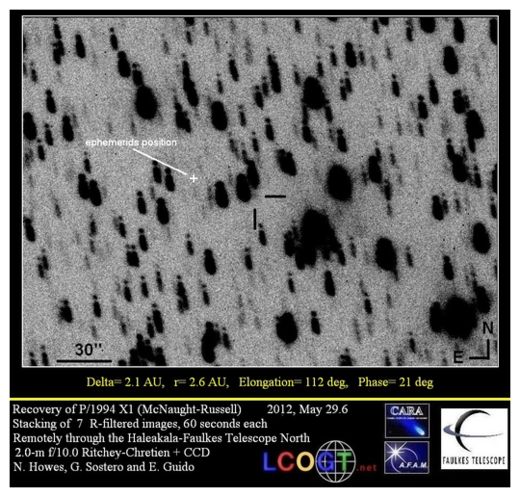
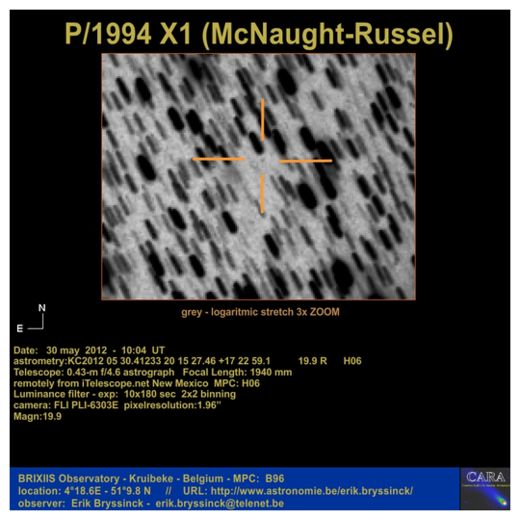
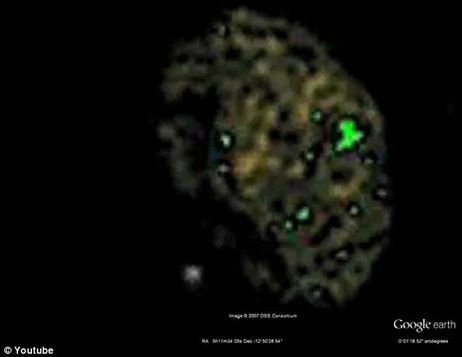

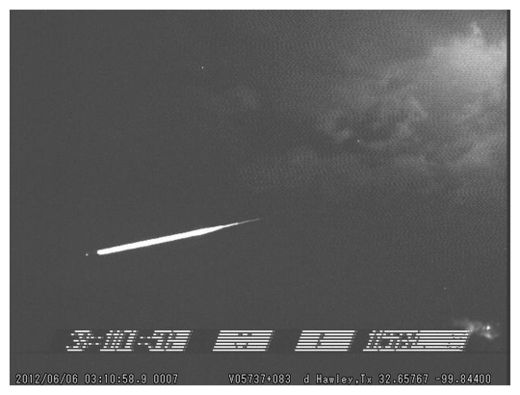
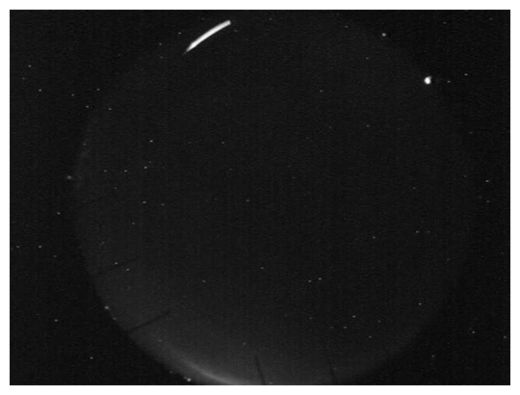


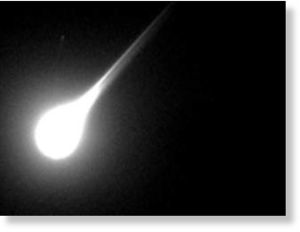
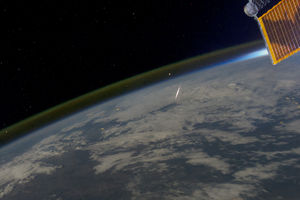
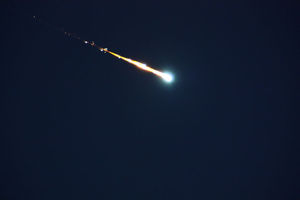
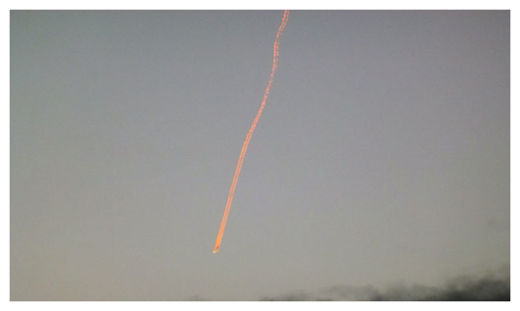
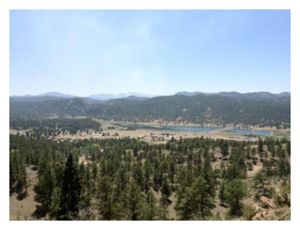

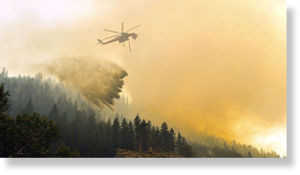

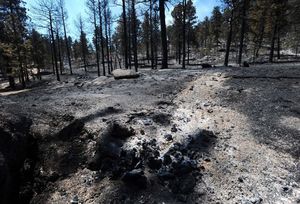
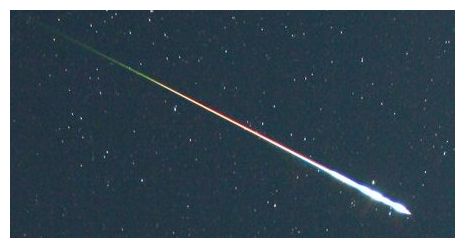
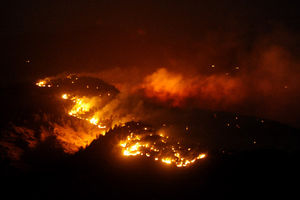
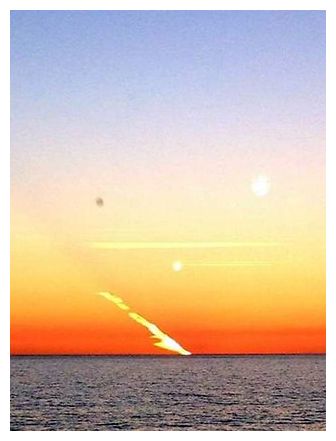

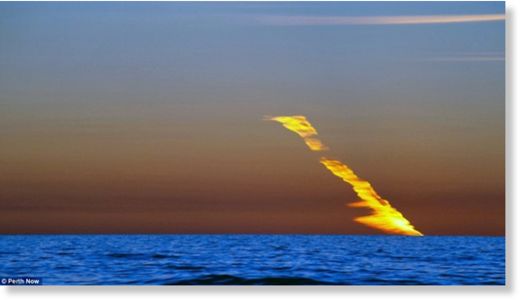
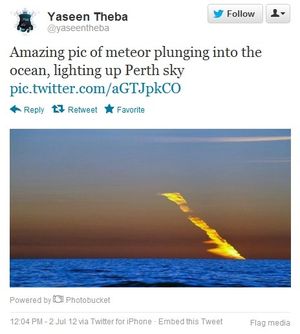


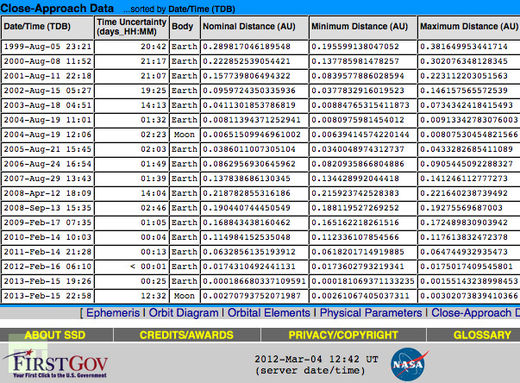
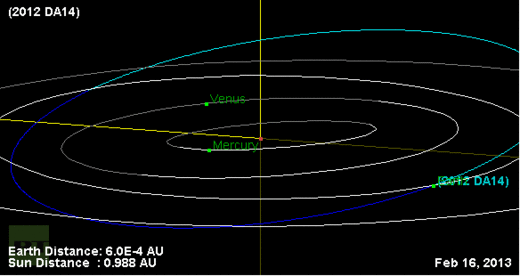
1 comment:
Keit, we need to talk about some bizarre fireball phenomena caused by satellite reentries -- email me at jamesEoberg@comcast.net, please.
Post a Comment